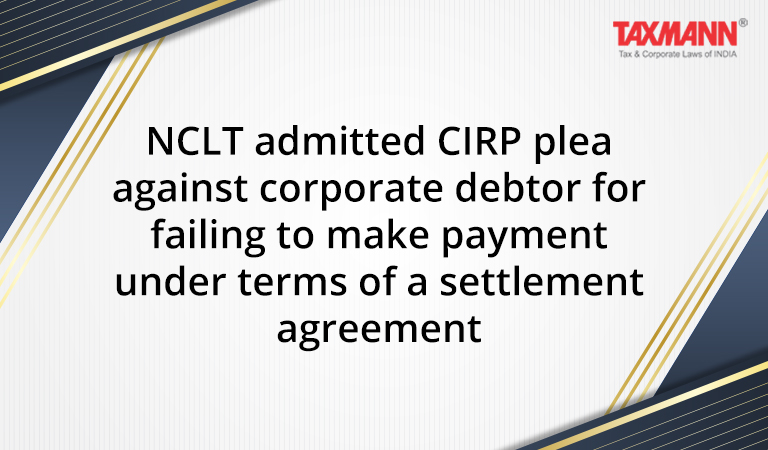NCLT admitted CIRP plea against corporate debtor for failing to make payment under terms of a settlement agreement
- Blog|News|Insolvency and Bankruptcy Code|
- 2 Min Read
- By Taxmann
- |
- Last Updated on 1 November, 2021

Case Details: Satish Sadashiv Rane v. Shah Group Builders Ltd. - [2021] 131 taxmann.com 270 (NCLT - Mum.)
Judiciary and Counsel Details
-
- Rajesh Sharma, Technical Member and Mrs. Suchitra Kanuparthi, Judicial Member
- Ansh Bhanot, Adv. and Ms. Priyanka Zaveri, Adv. for the Petitioner.
- Nitin Thakker, Adv. for the Respondent.
Facts of the Case
In the instant case, an application under section 7 of the Insolvency and Bankruptcy Code, 2016 was filed by the financial creditor against the corporate debtor for failing to make payment under the terms of the settlement agreement, and the said application was admitted by NCLT.
The financial creditor and corporate debtor subsequently executed a settlement agreement to settle outstanding loan obligations of the corporate debtor and to bring the corporate debtor out from the Corporate Insolvency Resolution Process (CIRP) and accordingly, the corporate debtor issued post-dated cheques to the financial creditor.
After entering into the settlement agreement, the corporate debtor approached NCLAT to record said settlement agreement and to set aside the CIRP proceedings.
NCLT Held
The NCLT after hearing both the parties set aside an admission order. However, when the financial creditor deposited cheques issued by the corporate debtor, and same were dishonored. Upon the occurrence of such default in repayment, the financial creditor filed an instant petition to set in motion the CIRP process against the corporate debtor.
NCLT held that the parties had executed the settlement agreement and the corporate debtor was obligated to strict adherence of terms and conditions of payment which he obliterated and committed default of payment terms.
Since the corporate debtor has committed default of payment terms under the settlement agreement. Hence, the financial creditor exercised his rights under the settlement agreement and has filed the instant petition. The petition filed by the financial creditor which was in compliance with provisions was admitted declaring a moratorium.
Disclaimer: The content/information published on the website is only for general information of the user and shall not be construed as legal advice. While the Taxmann has exercised reasonable efforts to ensure the veracity of information/content published, Taxmann shall be under no liability in any manner whatsoever for incorrect information, if any.

Taxmann Publications has a dedicated in-house Research & Editorial Team. This team consists of a team of Chartered Accountants, Company Secretaries, and Lawyers. This team works under the guidance and supervision of editor-in-chief Mr Rakesh Bhargava.
The Research and Editorial Team is responsible for developing reliable and accurate content for the readers. The team follows the six-sigma approach to achieve the benchmark of zero error in its publications and research platforms. The team ensures that the following publication guidelines are thoroughly followed while developing the content:
- The statutory material is obtained only from the authorized and reliable sources
- All the latest developments in the judicial and legislative fields are covered
- Prepare the analytical write-ups on current, controversial, and important issues to help the readers to understand the concept and its implications
- Every content published by Taxmann is complete, accurate and lucid
- All evidence-based statements are supported with proper reference to Section, Circular No., Notification No. or citations
- The golden rules of grammar, style and consistency are thoroughly followed
- Font and size that’s easy to read and remain consistent across all imprint and digital publications are applied





